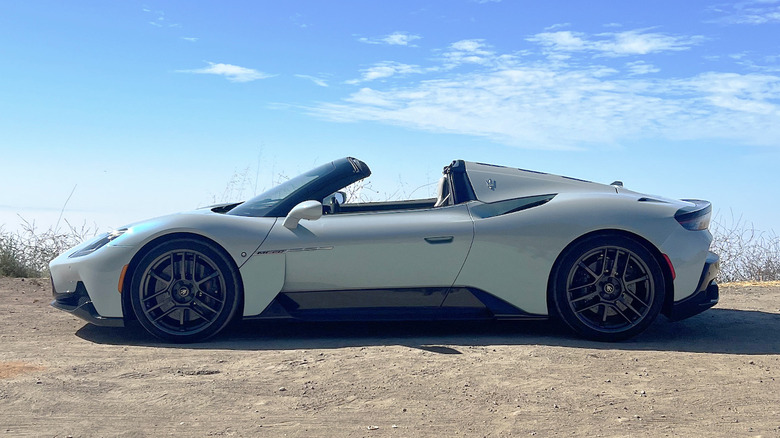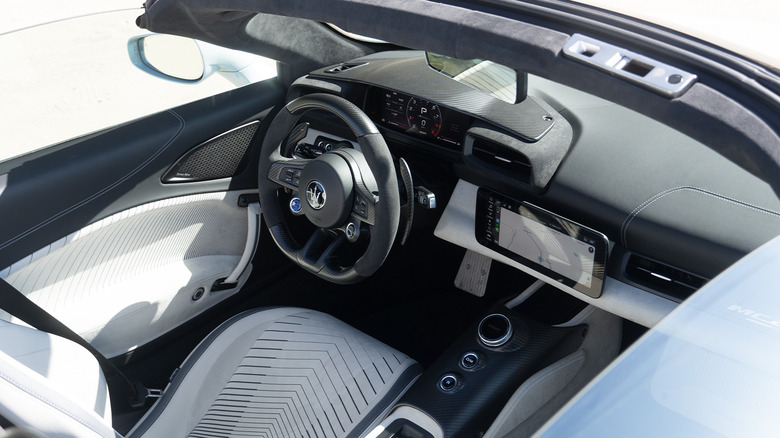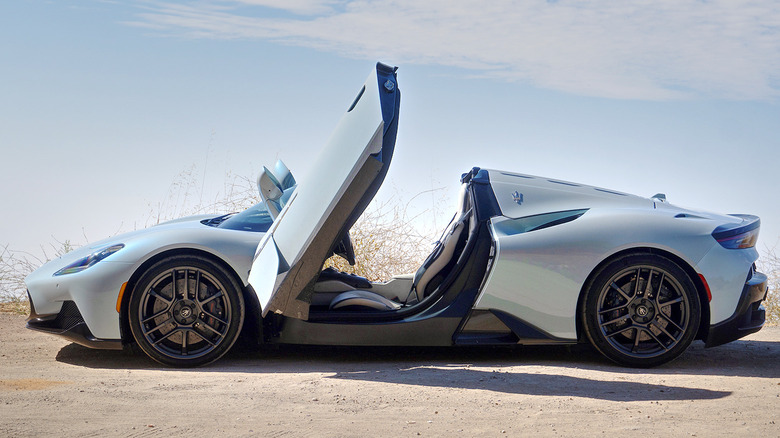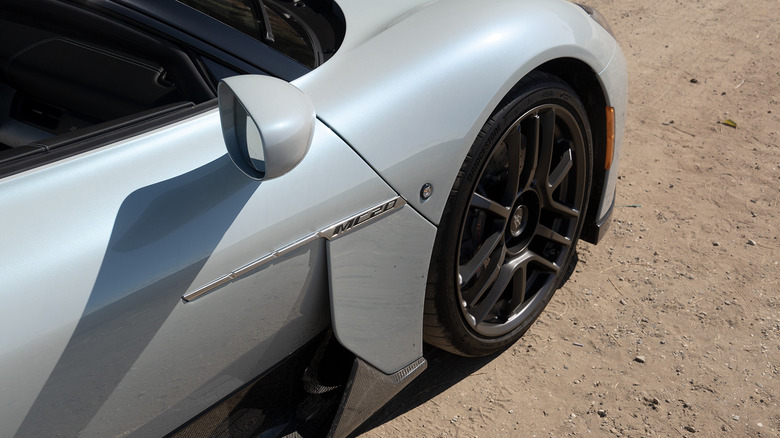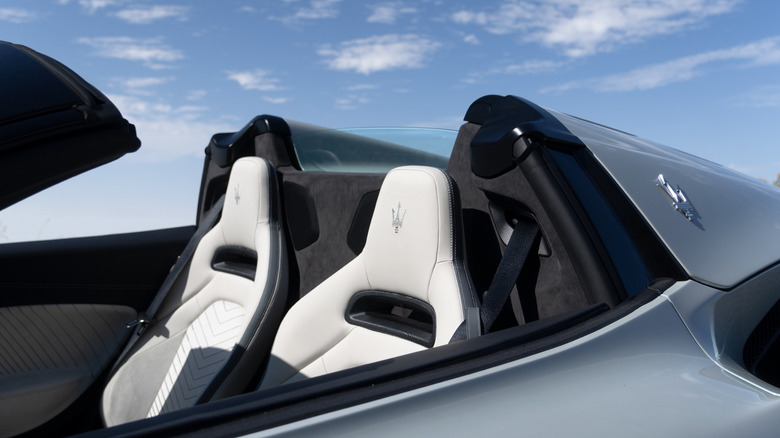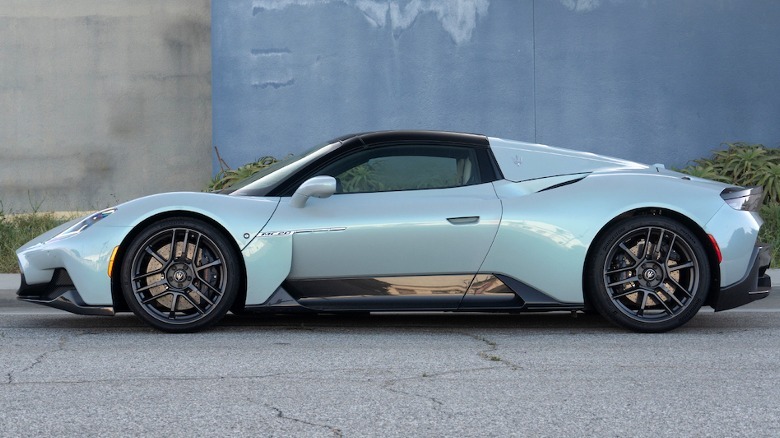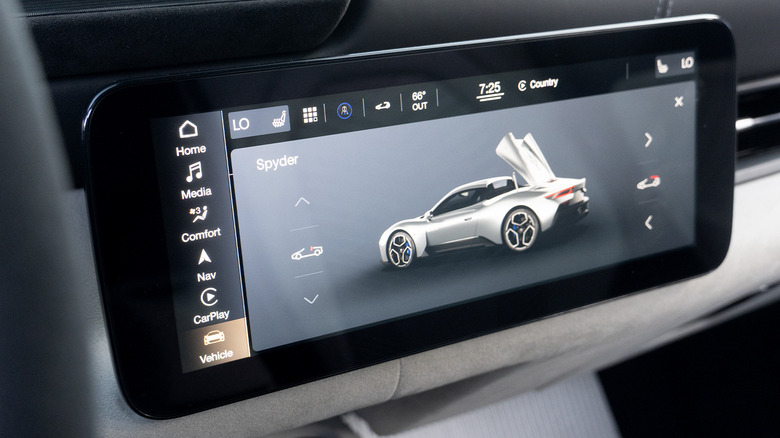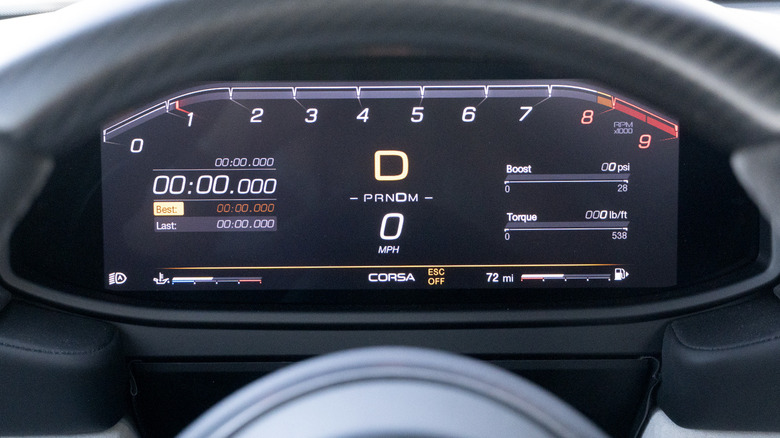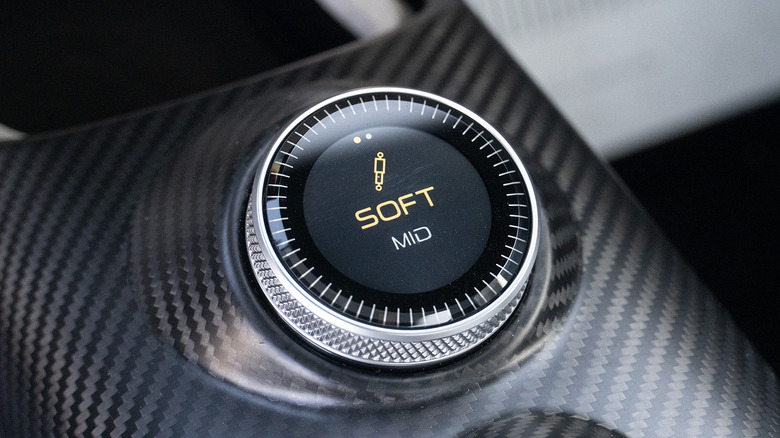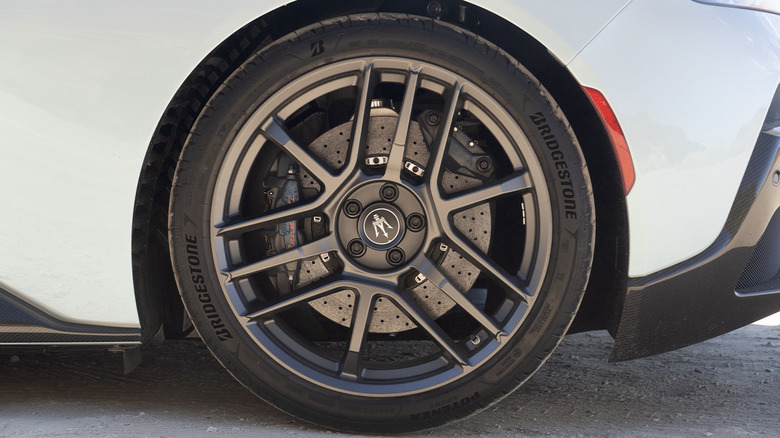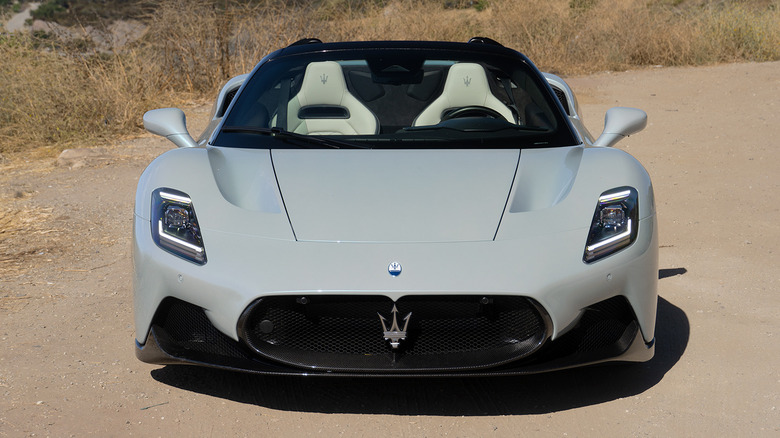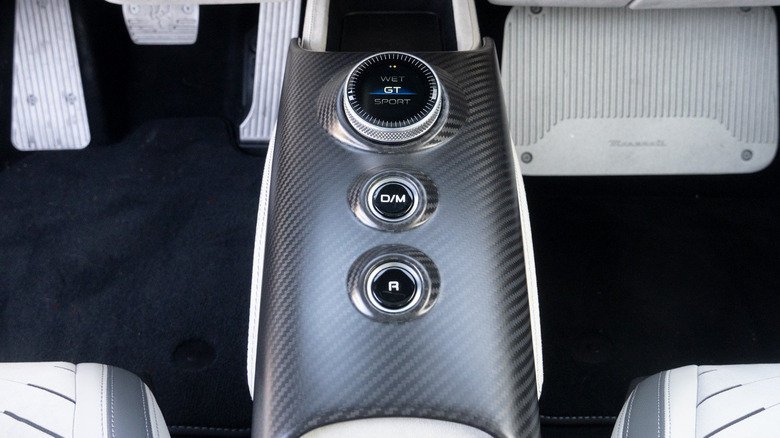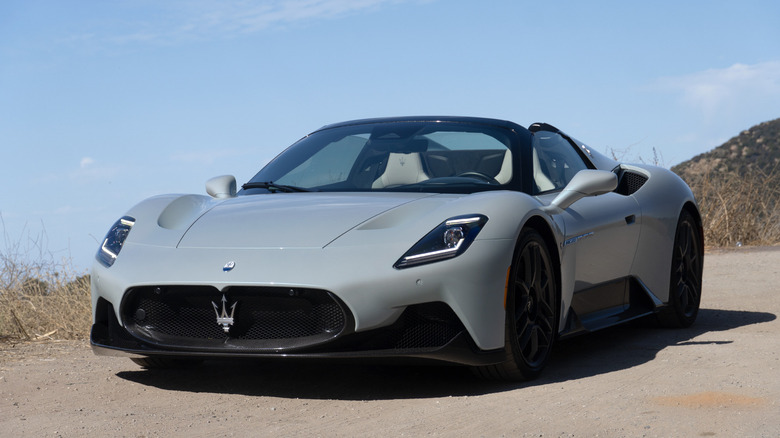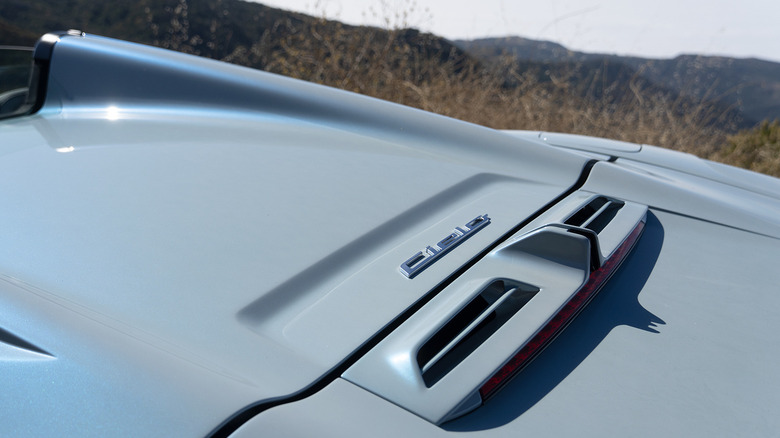2023 Maserati MC20 Cielo Review: A Convertible That Does What No Other Can
- New hardtop convertible layout
- Chassis and suspension revisions for smoother ride
- One of the best supercar designs ever
- Old-school performance from the futuristic Nettuno engine
- If you have to ask, you can't afford it
- Minimal storage in trunk, frunk, or cockpit
- A few parts seem slightly Fiat-ish
Not many convertibles ever manage to look better than their coupe counterparts. After all, design concerns often come secondary to the engineering challenges of a drop-top that can live up to both safety standards and driving dynamics. The modern era of hardtop convertibles has helped with aesthetics, as do removable Targa-style roof panels, but they've also exacerbated concerns about added weight, as well as reduced storage capacity and unfortunate crease lines.
Personally, I used to tell anyone who might listen that I never liked any convertible more than the coupe version. Until now, that is, because in that regard, Maserati's new MC20 Cielo is something of a first—even if it's the second variant of a supercar chassis that will also eventually include a track-only P24 and a full EV. Not that the MC20 coupe ever fell short in either design or performance terms, but the Cielo proves that a retractable hardtop can simultaneously deliver stellar style, comfortable open-air cruising, and unbelievable performance all in one package.
To put my obviously subjective tastes to the test, Maserati shipped out the first press loaner Cielo to Los Angeles, where I might best enjoy some wind in my hair while driving home from flogging a spectacular supercar in the canyons—and even get a taste of daily life with a true showstopper that can often seem conspicuously absent in the LA car scene.
Heart-thumping fun in the Maserati MC20
The MC20 originally debuted in coupe form only, with a 621-horsepower twin-turbocharged 3.0-liter V6 slung low in a lean carbon-fiber monocoque. The resulting combination of stunning good looks and raucous boosty turbo whooshes revive a lost sense of magic amid the current crop of anesthetized supercars that can sometimes seem to drive themselves. And I can prove as much with science, too, since I wear a Whoop strap that monitors my heartrate and will often ask whether I've completed an activity such as a bike ride, a long hike, or even wrenching on one of my cars.
Track time will also usually raise my heartrate enough to prompt the Whoop app to ask a series of questions about my recent activities. But no car ever managed to do so on public roads until my first time driving an MC20. Then it happened again, when I road-tripped a different MC20 to Joshua Tree a few months later. And once more a few months after that while driving an early Cielo briefly in the Italian countryside—so perhaps I should have expected as much my first morning out in Malibu driving this production Cielo loaner.
It sounds silly, I am aware. But why, out of all the sports cars, off-roading four-wheelers, and supercars I drive, does the MC20 get my heart all aflutter? Other than the lithe, supermodel good looks, that is... Well, I suspect that Maserati somehow tapped into the hardcore, gnarly, almost intimidating nature that made supercars in the mid-2000s such a phenomenon, as opposed to the refined characteristics that other manufacturers seem to prioritize these days. And make no mistake, pushing anywhere near the limit in the MC20—either the coupe or spyder—will undoubtedly bring on the kinds of sketchy moments that bring smiles to the faces of automotive enthusiasts the world over.
Toned down but not detuned
Surely, though, adding a retractable hardtop to the MC20 must tone down that raw nature, I figured before driving a Cielo for the first time. But Maserati's team kept a keen eye on weight gains, so the Cielo weighs only 65 kilograms (or 143 pounds) more than the coupe, for a total curb weight of 1,540 kg (3,395 lbs).
For reference, that's almost exactly 400 pounds less than a 992-gen 911 Turbo S, Porsche's all-wheel-drive sprint-stage superstar that pumps almost exactly the same amount of horsepower out of a larger 3.8-liter flat-six hanging off the rear end, rather than mounted amidships where it belongs. The Cielo's convertible top and mid-engine layout do present challenges in terms of chassis stiffness, however, and the direct profile shot above with the butterfly doors up and rooftop retracted reveals the minimal floor pan that must perform maximally when driven hard.
Chassis and suspension revisions
With the goal of combating potentially disconcerting chassis flex given the MC20's power output and handling capabilities, Maserati distributed carbon-fiber layers differently throughout the Cielo's monocoque to enhance torsional rigidity. The stiffer structure and added weight of the roof then prompted the use of firmer rear springs (5-7% beefier, Maserati tells me).
But a tighter chassis and stiffer springs run counter to the ethos of top-down cruising, so when compared to the MC20 coupe, the Cielo runs the dampers softer with GT mode selected—as well as revising the locking percentage and torque distribution for the electronically controlled rear differential, to create less reactive behavior under load.
The engineering updates manifest immediately in the real world, as the Cielo's compliant comfort in town gives way to communicative confidence in the canyons. Rough roads reverberate much less through the body and cockpit, as compared to the coupe, with speed bumps and expansion joints no longer creating jarring bumps or bangs. For something so low and light, the Cielo transforms the (often uncomfortable) supercar driving experience into serene pleasure—and that's before dropping the roof for real convertible fun.
Life with the top down
Retracting the Cielo's hardtop involves thumbing two pages deep in the native UI via a centrally mounted 10.25-inch touchscreen. First, the windows roll down, then the rear clamshell opens upward and the Targa-style roof flip-slides back underneath. The whole process takes only 12 seconds, going up or down, though the system stops working at speeds over 50 kilometers per hour (31 mph).
With the top removed, two aero fairing humps behind the headrest now stand out from the gentle bow of the closed clamshell. With or without the roof up, though, the Cielo's crisp lines remain coherent—no unsightly canvas folds up, no bulbous convertible top cover appears, and no rolling down quarter windows required.
Even better, the convertible MC20 offers more than just a retractable hardtop. The Cielo name actually refers to the glass roof's ability to switch from clear to an opaque white at the touch of a button, using polymer-dispersed liquid crystal technology. And a small roll-down window between the two aero fairings can also roll up and down, whether or not the roof is up or down, and further control how much wind actually enters the cockpit (one gripe I discovered: the side windows don't roll back up automatically once the roof finishes the folding or unfolding process).
Minimal sacrifices for a spyder
The Cielo's retracting hardtop must reduce storage space, right? Guess again: The rear trunk for both coupe and spyder still measures in at 100 liters of volume (3.5 cubic feet). That's small, without a doubt, and certainly not wide enough for golf clubs. And I can't recommend storing groceries in the rear trunk either, since heat from the Nettuno engine will just about toast bread on a long enough drive. The MC20's frunk also remains unchanged (read: borderline unusable), reducing any actual storage space to only the passenger seat and footwell.
But the main meaningful sacrifice that the Cielo demands only hit me when I stopped for a photoshoot at the top of Saddle Peak between Malibu and Topanga: Namely, the roof and clamshell cover now prevented me from snapping pics of, or even looking at, the engine bay. Otherwise, wind noise with the top down also drowns out the otherwise spectacular Sonus Faber sound system, which tries to compensate by automatically adjusting equalization if the roof is open or closed. But even while commuting around town, I only wanted to listen to the MC20's engine soundtrack anyway.
None more exotic than the Nettuno V6
And that's because the Nettuno V6, bar none, sounds different from any other engine on the market. The fact that a twin-turbo V6 displacing only 3.0 liters can crank out 621 horsepower and 538 lb-ft of torque comes as something of a surprise—as does an 8,000-RPM redline. On paper, the Nettuno's pre-chamber combustion system, derived from F1 tech, features twin spark plugs for every cylinder and must explain the engine's eminent brawn.
But I believe that Maserati also purposefully installed a tame exhaust system on the MC20 to enhance the noises that do enter the composed cockpit. Where most supercars show off with borderline egregious exhaust valving, the Nettuno highlights turbo whooshes and burbles and yelps at blow-off—all of which sound slightly more subdued in the Cielo, probably thanks to that clamshell cover, but rolling down the rear window with the top up turns the tunes up to 11 again and produces the most unique soundtrack this side of a Bugatti W16.
The little mill also produces so much power that just about anyone can be forgiven for thinking Maserati might well have underrated the official stats. That perception probably stems from the relatively low curb weight, in our current era of ballooning automobiles, but it's still no wonder the company also decided to install the same engine, albeit detuned slightly, in the Grecale SUV and revived GranTurismo.
Unleashing the Cielo's raw edge
Switching over to Sport or Corsa mode via a dial on the center console prompts a bit more exhaust rumble, but more serious changes to turbo boost, pedal sensitivity, gear shift settings, suspension, and traction control intervention. That dial itself is also new, with a touchscreen center that allows for the selection of damper settings with a swipe of the finger—the coupe only offered two suspension firmness settings, both of which feel tauter than Soft and Mid in the Cielo. Sport and Corsa allow for Mid and Firm shocks, while a button on the steering wheel activates Launch Control in Corsa mode only.
Even canyon carving in the softest GT mode, the Cielo handles better than just about the best sports cars on the market—think Porsche Cayman GTS 4.0 or Lotus Emira. At the bottom of Las Flores in Malibu, pebbles flicking up into the carbon chassis echo akin to an F1 racecar in the pits as a constant reminder of that capability. But switching over to Sport or Corsa and setting the dampers to Firm unleashes the MC20 coupe's original raw edge, reintroducing that hint of twitchiness under hard acceleration, cornering, or braking that sets my heartrate thumping.
Then, when I mash the throttle purposefully through a patch of running water left over from this past winter's atmospheric river storms, the rear wheels slip out into an easily controlled 30-foot drift. Not that the water is required, though, just Maserati's old-school traction control allowing quick slides that take a momentary flick of countersteer to correct. A punch of throttle out of any tight turn coaxes the 305-millimeter Bridgestone Potenza Sport rear tires into stepping out with ease, chirping in protest, and skirting into oversteer with aplomb.
The forgotten art of automotive engagement
That instantaneous moment of yaw reveals just how well the thicker carbon layup and stiffer springs mask any additional weight gains of the retractable hardtop, but also the undeniably anachronistic nature of the MC20's traction control settings. Instead of dialing back overzealous throttle input, Maserati clearly accepts that drivers will want to engage in such shenanigans, and allows the darker angels of our nature to enjoy a second or two of doubt before the e-LSD hooks up and the Nettuno revs back into full boost with a building rush of pure exhilaration.
Smack the column-mounted shifters a couple of times in any straight, as the eight-speed DCT bangs through shifts at full wallop, and then punch the brake pedal for those Brembo carbon-ceramics to gnaw down speed into the next corner, dipping the nose almost imperceptibly while the tail end shimmies with delight until the 245-mm front tires hustle through to apex and the entire concerto enters the next interval. Forget speed limits—where we go we don't need speed limits, just the implacable thrill where romping fun meets the fear of damaging a $300,000-plus work of rolling art.
Tech can make or break a $300,000 supercar
Part of why the MC20 makes my Whoop strap ask whether I've exercised recently involves that traction control and ESC programming. The adrenaline-laden edge of sanity pushing such an expensive, exotic car hard demands that tech help, rather than hinder, the overall driving experience. Now go tell that to other supercar manufacturers, who need to cater to the lowest common denominator of buyers most likely to produce the highest number of damaging headlines and social media clips.
And plenty of the Cielo's tech undoubtedly enhances the overall experience, whether driving to the grocery store or hammering through canyons at ungodly (dubiously legal) pace. As opposed to the first years of the MC20 coupe, the Cielo now introduces Maserati's new suite of driver aids including a very helpful blind-spot monitoring system and a digital rearview mirror—two critical details in a low two-door with minimal visibility.
A few Fiat-ish details
Switches on the turn signal and windshield wiper stalks, behind the column-mounted paddle shifters, also allow for additional configuration of the 10.25-inch gauge cluster. I typically kept the right field showing either tire temperatures or boost and torque output stats, with the left showing my trip and odometer readings. A button on the steering wheel also makes for easy use of the front-axle lift system, which raises the nose by 50mm (just shy of two inches) at speeds up to 40 kph (just below 25 mph).
Nobody prefers column-mounted shifters, though, and the push buttons on the center console also lend a decidedly Fiat-ish air to the otherwise premium MC20 interior. Such concessions to the bean counters also bring to mind questions of reliability, both for the electronic components and such a potent powertrain. Otherwise, a single cupholder actually placed perfectly between the two seatbacks and an excellent little cubby for phone storage and charging prove that supercar design needn't necessarily sacrifice ergonomics and daily utility in the name of sheer futurist exoticism.
Superstars among supercars
I also found myself wishing the key fob allowed me to retract the roof from outside the car, to sidestep the heat during this Southern California summer's first real series of nonstop scorchers. But otherwise, my time with the Cielo left me truly wondering whether any other supercars can beat such a unique combination of design, dynamics, and daily drivability. Of course, a few can undercut the price, since this specific Primaserie Launch Edition finished in an exclusive opalescent blue Acquamarina paint stickers for a borderline unbelievable $339,700.
That's par for the supercar course over a $261,200 base price, almost half of which comes courtesy of the Exterior Carbon Fiber Pack that runs for $39,000 alone. Now tack on the optional carbon-fiber wheels—which Maserati's PR team in their infinite wisdom decided not to risk a bunch of journalists curbing, but would have saved an additional 30 kilograms (66 pounds) of total unsprung weight and possibly improved the driving experience even more.
In the neighborhood of $300,000 and up, the Cielo undoubtedly faces stiff competition. The Lamborghini Huracán Tecnica I drove only a few weeks prior combines a rowdy V10 with angular styling and a few compromises for daily use at a similar price point. But here in LA, Huracáns around every corner blunt some of the appeal that Lambos used to inhabit. A McLaren 720S Spider starts at $326,500 and pumps 710 horsepower out of a twin-turbo V8, all in a svelte package that can probably lay down better lap times than any road-legal MC20. But even McLarens are now a dime a dozen at the Malibu Country Mart, whereas I have seen a grand total of two other MC20s—and zero Cielos—that I can recall other than my press loaners here in the past few years.
Maerati's ICE victory lap
The last laugh, as usual, goes to science: As much fun as I've had in Lamborghinis and McLarens and Ferraris, none have ever sent my Whoop strap and app into a frenzy. And now, with the Cielo's sublime chassis improvements and choice of roof configurations in an undeniable stylistic masterpiece, Maserati's decision to artificially enforce scarcity only seems all the more cruel to mere mortals hoping to catch glimpses of such a unique supercar. And I, as a spoiled rotten automotive journalist, can only wonder what the P24 or EV variant might manage as Maserati transitions to the inevitable electric age.
Can either a dedicated track star or a fully electric drivetrain hope to outgun a grey-over-black MC20 Cielo with carbon rims and the carbon exterior package? Because if I had to choose one supercar to actually live with and love, my bedraggled brain currently stalls trying to think up anything better. And I never even liked convertibles.
